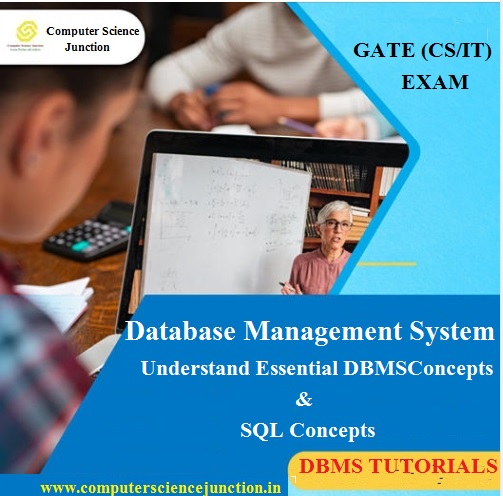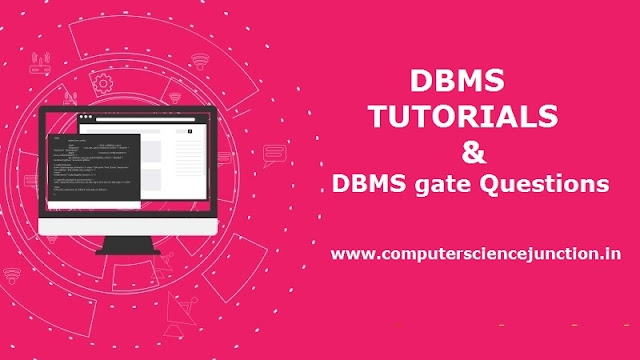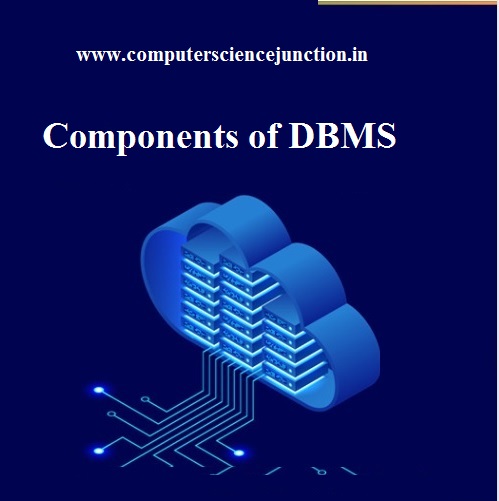Table of Contents
- 1 DBMS Tutorial
- 1.1 DBMS Course Structure
- 1.2 Database Management System Tutorials
- 1.2.1 PART 1 – Basics Concepts of DBMS
- 1.2.2 PART 2 –Entity Relationship Diagram
- 1.2.3 PART 3 – Relational Algebra Operations and RDBMS Basics
- 1.2.4 PART 4 – Normalization and Decomposition in DBMS
- 1.2.5 PART 5 – SQL
- 1.2.6 PART 6 – Transaction Management System
- 1.2.7 DBMS GATE Questions
- 1.2.8 GATE Exam Syllabus for DBMS
- 1.3 Database Management System Tutorial Description
- 1.4 DBMS Learning Objectives
- 1.5 Course Output
- 1.6 Audience
- 1.7 Conclusion and Summary
DBMS Tutorial
- Database Management Systems or DBMS is an essential subject of the Computer Science Branch.
- Questions from DBMS are generally asked in the GATE CSE and UGC NET exams.
- DBMS Tutorial for various topics of DBMS are appropriately explained here.
- These Database Management System notes are prepared for computer science students or those preparing for the GATE (CS/IT) exam.
- Topics covered in this database management system notes pdf are per gate cse syllabus.
- Students from the computer science branch will understand the basic concepts of Database Management Systems Subject.
- Examples of database management system concepts are also given in each Tutorial.
- Previous Year GATE Exam Questions from the database management system are also solved with proper explanation in a separate Tutorial linked in this post. Some essential modules covered in this database management system notes pdf are as follows.
DBMS Course Structure
- Database Management System Notes are available here as a wise Tutorial.
- To read the Tutorial, click on the Topic name mentioned before the Tutorial Number.
Database Management System Tutorials
The list for DBMS Tutorial prepared by Computer Science Junction for computer science students is given below.
PART 1 – Basics Concepts of DBMS
In this part, DBMS tutorials related to basic concepts of DBMS, such as introduction and characteristics of DBMS, components of DBMS, three-level architecture of DBMS, Data independence, DBMS Languages, and Transaction Control Language, are given for the study of students.
Tutorial 1 –DBMS Introduction and Characteristics of DBMS
Tutorial 2 – Components of DBMS
Tutorial 3 – Database Architecture or DBMS Three-Level Architecture
Tutorial 4 –Data Independency in DBMS.
Tutorial 5-Database Languages or DBMS Languages.
Tutorial 6 – Transaction Control Language in DBMS with Example
PART 2 –Entity Relationship Diagram
Entity Relationship Diagram is used in the design phase of DBMS. Once the ER Diagram is prepared, the Database tables are created from the ER Diagram using the conversion rule.
ER Diagram Tutorials are given below.
Tutorial 7 – Entity Relationship Diagram.
Tutorial 8 –Differences Between Generalization and Specialization
PART 3 – Relational Algebra Operations and RDBMS Basics
Tutorial 9 – Relational Algebra in DBMS
Tutorial 10 – Relational Database Management System
PART 4 – Normalization and Decomposition in DBMS
Tutorial 11 – Functional Dependency in DBMS
Tutorial 12 – Anomalies in DBMS
Tutorial 13 –Normalization in DBMS and Database Normalization
PART 5 – SQL
Tutorial 14 – Views in SQL
Tutorial – Procedure in SQL
PART 6 – Transaction Management System
Tutorial 15 -Transaction in DBMST
Tutorial 16 – Transaction State Diagram
Tutorial 17 – ACID Properties of Transaction in DBMS
Tutorial 18 –Schedule, Types of Schedule, and Conflict Serializability in DBMS
Tutorial 19- Database Recovery in Transaction Management System
Tutorial 20 – Deadlock Handling in DBMS
Tutorial 21 – Concurrency Control in DBMS
Tutorial 22 – Locking Techniques in DBMS
Tutorial 23 – Difference between MongoDB and SQL Databases
More Tutorials are coming soon…..
DBMS GATE Questions
In this section, we will learn about different DBMS GATE questions that need to be asked.
Questions SET1 – SQL Queries Based GATE Exam Questions
Questions SET2 –Entity Relationship Based DBMS GATE Questions
Questions SET 3 – DBMS GATE Questions and Answers on Normalization
Question SET 4 – UPTU Previous Year DBMS Questions Paper
Question Set 5 –DBMS Interview Questions and Answers.
More Articles are coming soon…….!
GATE Exam Syllabus for DBMS
The syllabus for the DBMS Subject for the GATE CSE exam is given below.
(a) ER diagram examples.
(b) Relational model: relational algebra in database, tuple calculus, SQL. Integrity constraints, rdbms pdf, normalization in dbms.
( c ) File organization indexing (e.g., B and B+ Trees).
(d) Transaction Management.
Every year, questions scoring 6 to 8 marks are generally asked in gate exams from these database management system tutorial topics.
In this post, you will get various articles related to database management system notes, practice sets, and examples of database management systems that will help you solve the DBMS-related questions for the GATE Exam.
Database Management System Tutorial Description
- Today, Databases are an integral part of most information systems.
- In this course, we will develop an understanding of how data is collected, organized, used, and managed in a DBMS environment.
- The emphasis will be on general concepts and theoretical foundations, and thus, we will not focus on any particular commercial system in the DBMS environment while preparing this Tutorial.
DBMS Learning Objectives
After completing the database management system course, students will understand and learn the following concepts of the database management system. These are the course outcomes of DBMS
- Know basic concepts of DBMS.
- Able to comprehend Data Modeling using the Entity-Relationship Model.
- Understanding of Relational Data Model and Language.
- Able to execute SQL queries on the database.
- Able to understand the Data Base Design and normalization concepts.
- Know Transaction Processing Concepts
- Students have an understanding of Distributed Database concepts
- Students know Concurrency Control Techniques
The student will be able to solve GATE/UGC NET problems of DBMS.
Course Output
As a result of this DBMS environment-based course, the student will relate the importance of database systems in computer applications. Understand the complexities of designing, using, and implementing database systems and applications.
Apply the principles and techniques of database management to a database system project. Understand and use SQL to administer and query a database.
Audience
This database management system notes pdf is specially written for candidates preparing for the GATE(CS/IT) and UGC/NET exams. This Tutorial will also help computer science graduates of various courses such as BCA, MCA, B.Tech(CS/IT), and M.Tech to understand the basic, intermediate, and advanced concepts related to database management systems.
Conclusion and Summary
In this database management system tutorial, we have discussed the following points
- Importance of Database Management System Subject.
- DBMS Learning Objectives
- Pre-requisite
- Audience
- DBMS Syllabus for GATE(CS/IT)
- Tutorials on different concepts of DBMS.
- DBMS GATE(CS/IT) questions





